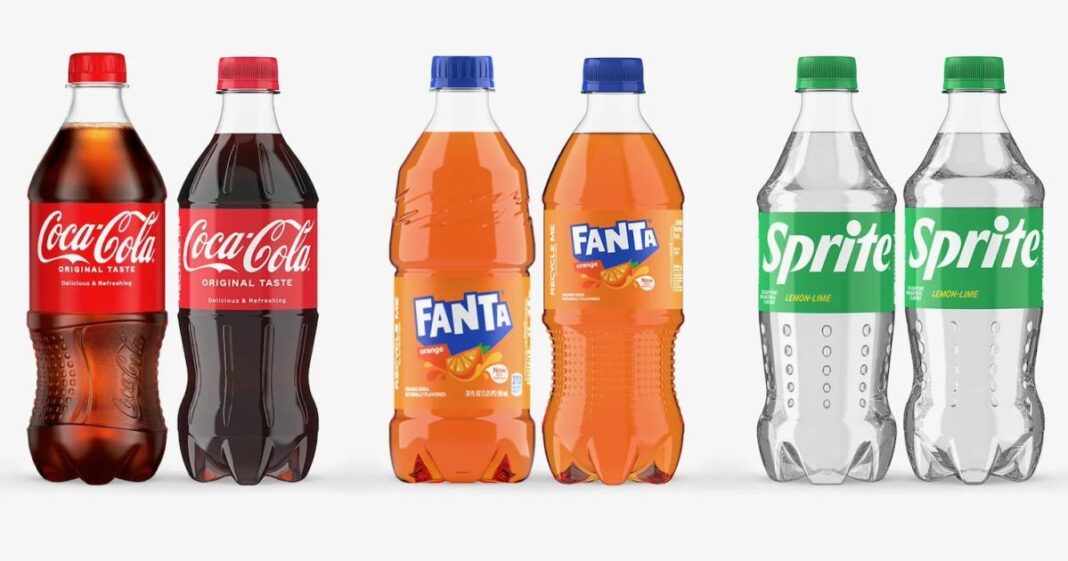Coca-Cola is changing the shape of single-serve plastic bottles across its Sprite, Fanta, Coca-Cola and Minute Made product lines in an effort to reduce the average weight by more than 31 percent.
The initiative applies to 12-, 16.9- and 20-ounce polyethylene terephthalate (PET) bottles and affects the company’s most popular beverages, including those listed above as well as Fresca, Mello Yello, Pibb Extra, Seagram’s and Barq’s (which are using the same updated bottle shape as Fanta). The switchover will cost bottlers and the Coca-Cola distribution network about $52 million across the U.S. and Canada. That money will update bottle molds and filling equipment.
The measures will cut Coca-Cola’s new plastic usage by approximately 800 million bottles in 2025, according to the company. That translates into an average 17 percent per-bottle emissions reduction, or the equivalent of taking 17,000 cars off the road next year, according to Coca-Cola’s life-cycle assessments.
Coca-Cola’s previous efforts reduced its plastic bottles from 27 grams to 21 grams over the past 10 years. Most single-serve bottles will now weigh 18.5 grams; some will be even lighter, at 17.75 grams, depending on the bottler.
“These are the highest-selling products that we have,” said Alejandro Santamaria, senior director for packaging development and innovation at Coca-Cola. “These are the SKUs that will have the most impact in terms of both plastic and emissions reductions.”
Bottlers, resin suppliers, others consulted
Coca-Cola packaging designers made the bottles thinner but did not alter the height or overall diameter, which kept existing transportation and display processes in place, Santamaria said.
The project started in April 2021 and field-tested in 2022, he said. Next up for a redesign are the company’s 2-liter and 24-ounce PET multiserve bottles.
Coca-Cola’s sustainability strategy is set by its executive leadership. Delivering takes cooperation from its global network of bottlers, which turn syrups from the Atlanta-based company into the products on store shelves. Bottlers meet regularly to share operational best practices, environmental stewardship. More than 60 will be affected by this change.
“We work together closely on these matters,” said Mike Bernier, director of sustainability for Swire Coca-Cola, which sells the company’s beverages across 13 Western states. “We had to make the decision together, but it didn’t take that long” to agree on the change, he said.
One piece of a complicated puzzle
Packaging represents about 30 percent of Coca-Cola’s overall greenhouse gas emissions. The lightweighting effort is part of several Coca-Cola packaging goals pegged to 2030, including:
- Make all packaging recyclable: It’s at 90 percent as of the company’s progress report published in April 2023, although that assumes the infrastructure is in place to handle it.
- Use 50 percent recycled content: It’s at the halfway point. One recent development is a decision to use recycled plastic for all 20-ounce bottles sold in the U.S.
- Have at least 25 percent of beverages sold in refillable or returnable packaging: The most recent reported figure is 14 percent.
In addition, Coca-Cola pledged several years ago to cut virgin plastic from non-renewable sources by 3 million metric tons. While incremental efforts such as lightweighting have reduced per-bottle consumption, rising sales volumes have so far wiped out any cumulative progress, the company said in the sustainability report.
Coca-Cola routinely tops lists tracking consumer brands using the most plastics. It produces an estimated 134 billion PET bottles annually, or about 23 percent of all PET plastic bottles, according to research cited by the Plastic Pollution Coalition. Coca-Cola declined to share volumes for the brands involved in the lightweighting effort.
Calls for more reusable packaging
Using less plastic is important, but Coca-Cola should use more glass and aluminum and expand refillable and reusable options, said several experts about the link between plastic and climate change.
“Reducing the weight of plastic items by a few grams is not sufficient action to seriously address plastic pollution and all of the impacts that plastic has on people and the planet,” said Erica Cirino, communications manager for the Plastic Pollution Coalition.
Some regions already rely heavily on reusable bottles, and Coca-Cola should play into that, said Matt Littlejohn, senior vice president for strategic initiatives with Oceana. More than half of the Coca-Cola containers in the Philippines, for example, are reusable; Chile and Mexico also have strong foundations for reuse, according to Oceana research. “Coca-Cola is by far the dominant player in reuse for non-alcoholic beverages,” Littlejohn said.
Expanding reuse would require the opposite sort of investment as lightweighting, to ensure that bottles can stand up to multiple collection, cleaning and fill cycles, said Douglas McCauley, a professor of ocean science at the University of California Santa Barbara and director of the Benioff Ocean Science Laboratory. “There’s a bigger conversation that needs to happen about the material you could use for reuse, the footprint for glass versus thicker PET,” he said.
Moving to refillable containers is less feasible in countries without well-established facilities for collection, cleaning and refill, said Coca-Cola’s Santamaria. “What we’re trying to do is fit within the current infrastructure,” he said. “What is the quickest, easiest thing that we can do to bring quick value to the system? That is the most efficient thing we can do.”
